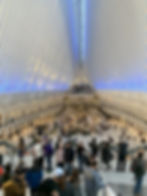Exploring The Oculus: New York City's Futuristic Architectural Mall and Transportation Hub
- Mark Vogel
- Dec 4, 2023
- 3 min read
Updated: Dec 30, 2024
New York City ✈

My recent visit to The Oculus in New York City was a revelation of what an architectural masterpiece looks like. Located in Lower Manhattan, adjacent to the 9/11 Memorial, this futuristic structure serves a dual purpose. The Oculus is both a transit hub and a shopping mall, seamlessly integrating daily commute with retail experience.

“The Oculus is a symbol of renewal and hope in the heart of New York City.”

The Oculus stands on a site heavily impacted by the events of September 11, 2001. Its construction is part of the broader World Trade Center redevelopment effort, aiming to revitalize the area while paying homage to the tragic events that occurred there.
Designed by the renowned architect Santiago Calatrava, The Oculus is a striking example of contemporary architecture. Its design resembles a dove being released from a child's hands, symbolizing peace. The building's structure, predominantly white, adds a sense of purity and hope to the area. The architect was inspired not only by the image of a dove but also by the human eye. The Oculus represents an "eye" to the sky, a metaphorical element that connects the busy city with the tranquil sky above.

The most remarkable aspect of The Oculus is its futuristic, space-age appearance. The rib-like structure of the building creates an illusion of movement and fluidity, a stark contrast to the surrounding skyscrapers of Manhattan. This design not only makes The Oculus a standout landmark but also a symbol of modernity and resilience.
The interior of The Oculus is as striking as its exterior. The white marble used throughout the structure enhances its light and airy feel. The vast open space inside gives a cathedral-like impression, which is both awe-inspiring and welcoming.

One of the most notable features of The Oculus is its skylight. This skylight opens annually on September 11th to honor the memory of the 9/11 attacks. This poignant feature allows a shaft of light to fill the space, creating a solemn and reflective atmosphere.
The construction of The Oculus was an engineering marvel. The structure's steel ribs and glass panels are not only aesthetically pleasing but also represent a complex feat of engineering, especially considering the challenges of building on a site with such profound historical significance and logistical constraints.
The design of The Oculus also takes into account environmental factors. The natural light that floods the space reduces the need for artificial lighting, and the structure's orientation and design contribute to energy efficiency.

Beyond its architectural significance, The Oculus functions as a major transit hub, connecting various subway lines and the PATH trains, facilitating the daily commute of thousands. The connected Fulton Street station serves lines A, C, J, Z, 2, 3, 4, and 5, while the nearby Cortlandt Street station serves the R and W lines. The Port Authority Trans-Hudson (PATH) trains connect New Jersey with Manhattan. The World Trade Center station is a terminus for PATH services coming from Newark, Harrison, Jersey City, and Hoboken.
Additionally, its role as a shopping mall brings a dynamic mix of retail and dining options, contributing to the economic and social revival of the area. The Oculus has also become a cultural and artistic venue. It hosts various events, exhibitions, and performances, making it an

important spot in the city's cultural landscape. The Oculus has played a significant role in the economic revitalization of Lower Manhattan. By attracting tourists and serving as a central hub for commuters, it has significantly contributed to the local economy.
The Oculus is a symbol of renewal and hope in the heart of New York City. Its unique architecture and dual functionality make it a must-visit for anyone exploring the city.



















